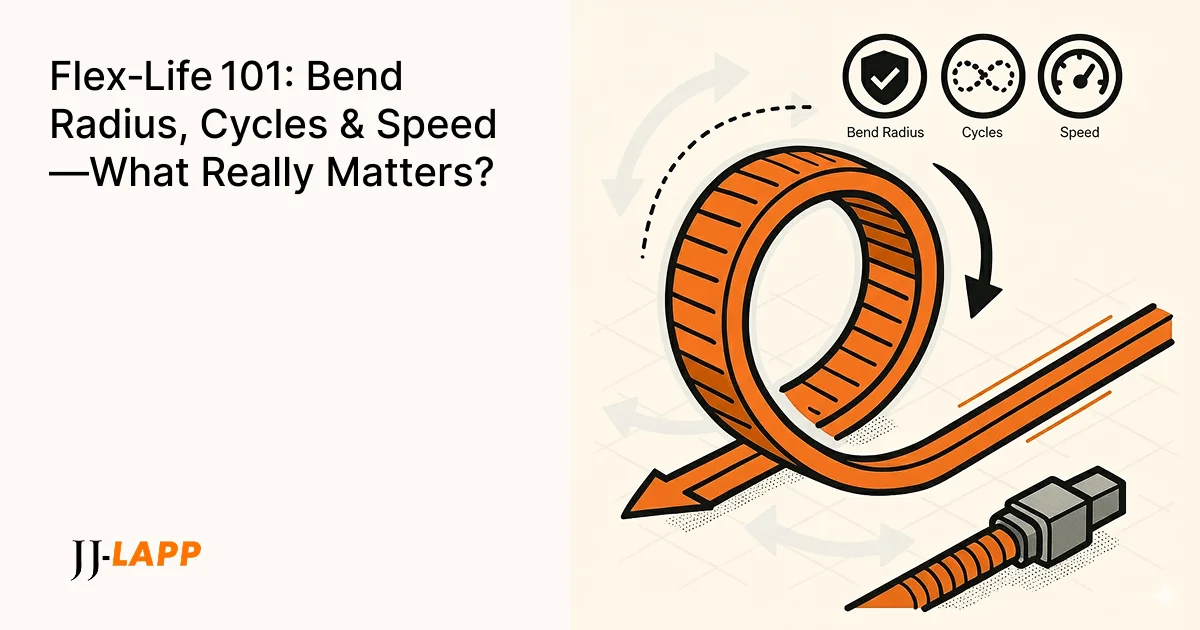Your new automated production line in Thailand stops. The diagnosis: a failed cable in the main robotic arm, just three months into service. One unplanned robot‑cable swap can cost thousands in lost output and labour. The datasheet promised “flexibility,” but it didn’t match the real‑world stress of your application. This downtime was preventable.
Choosing a “flexible” cable isn’t enough. Service life depends on bend radius, cycles, speed/acceleration, and torsion—all together. Use the guidance below to spec a purpose‑built ÖLFLEX® cable and avoid premature failure.
The 4 Pillars of Flex‑Life: Your Design Window
Exceed the design window on any one pillar and you risk early failure.
| Stress | Typical design window (by family/size) | Failure mode if exceeded |
| Bend radius | 7.5–10 × OD in drag‑chain families (series‑dependent) | Conductor fatigue, jacket cracking, “corkscrew” deformation |
| Cycles | Multi‑million (variant‑dependent; validate via datasheet & LAPP selection tables) | Conductor/jacket fatigue, corkscrew |
| Speed / Accel | Specified by series (consult product PDF; match your stroke length and chain geometry) | Core migration, frictional heating |
| Torsion | ±180 to ±360°/m (robot types; family‑dependent) | Shield discontinuity, corkscrew |
Formula: Minimum bend radius (mm) = Cable OD (mm) × rating (e.g., 9 mm × 7.5 = 67.5 mm).
Source note: Use LAPP’s product PDFs and catalogue selection tables (e.g., CHAIN/FD families and ROBOT families) to match radius + stroke + speed. For torsion, see ÖLFLEX® ROBOT guidance.
1) Bend Radius: The Non‑Negotiable
This is the tightest turn a cable can make without harming its core. Forcing a tighter bend than rated is like bending a paperclip back and forth—expect conductor breakage and insulation fatigue. Choose chain‑rated families (e.g., ÖLFLEX® CHAIN series) and design the energy chain so the physical bend radius ≥ cable’s dynamic rating.
Browse chain‑rated options on the JJ‑LAPP eShop.
2) Flex Cycles: A Number with Context
A promise like “5 million cycles” is only valid for the test set‑up used. Always check the current datasheet and the selection table to confirm performance at your bend radius, stroke, and temperature. If you increase speed or reduce radius, expect a shorter life.
3) Speed & Acceleration: The Hidden Stress
Higher speeds and quick accel create larger inertial forces and more core‑to‑core friction. If the cable isn’t designed for that regime, you’ll see heating, jacket wear, and core migration. Match the speed/accel envelope published for the family and keep chain fill, separators, and routing tidy to limit friction.
4) Torsion: The Twisting Force
Twisting stress is different from bending. A 6‑axis robot path needs a torsion‑optimised core design (low‑friction wraps, suitable shielding, PUR jackets). Using a linear drag‑chain cable in a torsional path is the classic recipe for corkscrewing and intermittent signals.
See LAPP’s torsion families such as ÖLFLEX® ROBOT 900 P on the eShop JJ-LAPP products page,
Why the Jacket Material Matters (PUR vs PVC)
For high‑flex duty—especially in hot, humid, oily environments—PUR jackets offer abrasion and notch resistance and are common in chain/robot families. PVC control cables are excellent for fixed/occasional flex, but age faster under continuous motion and oil exposure.
Matching the ÖLFLEX® to the Mission
Pick a family designed for your stress profile (always confirm the exact part‑number datasheet).
| Application type | Key stress | Recommended ÖLFLEX® family | Typical dynamic radius* |
| Stationary / occasional flex | Basic flexibility | ÖLFLEX® CLASSIC 110 | 10 × OD (occasional) |
| Continuous flex (drag chain) | Bending cycles, abrasion | ÖLFLEX® CHAIN families (e.g., TM / 809) | 7.5–10 × OD by series |
| High‑duty continuous flex | Bending + speed/accel | ÖLFLEX® FD families (e.g., FD P / FD Classic) | Per datasheet (series‑dependent) |
| Torsional (robotics) | Twisting + bending | ÖLFLEX® ROBOT 900 P / 900 DP | ±180…±360°/m (type‑dependent) |
*Values vary with family, cross‑section, and test set‑up. Always use the current product PDF.
Common Mistakes That Drive Failures
- Using a standard control cable in a drag chain. It lacks chain‑rated construction—expect fast wear and conductor breaks.
- Ignoring the chain’s physical bend radius. The chain radius must be ≥ cable’s dynamic rating (and ideally larger).
- Putting chain cables on torsional paths. Use robot‑rated families for multi‑axis twist.
Quick Answers
What is a “torsion angle”? Allowed twist per metre. Robot cables commonly specify ±360°/m (one full turn per metre) without damage—check the datasheet for your size.
Does temperature affect flex‑life? Yes. Heat softens jackets and increases internal friction; cold makes materials brittle. Stay within the flexing temperature range on the datasheet.
Do I need shielding in a drag chain? For VFD power and high‑frequency data (EtherCAT, PROFINET), use correctly shielded motion cables. Shield concepts (braid/spiral/foil+braid) are chosen to maintain EMC under continuous motion.
The Bottom Line: Specify for the Real World
Your automated systems are the heart of your production. Don’t let a poor cable choice be the weak point. Look beyond the “flexible” label and match the cable’s design to your actual bend radius, cycles, speed/accel, and torsion to achieve reliable, multi‑million‑cycle performance.
Ready to stop preventable downtime? Talk to a JJ‑LAPP automation specialist for a quick flex‑life audit
Local stock. German quality. Reliably Connecting ASEAN.
